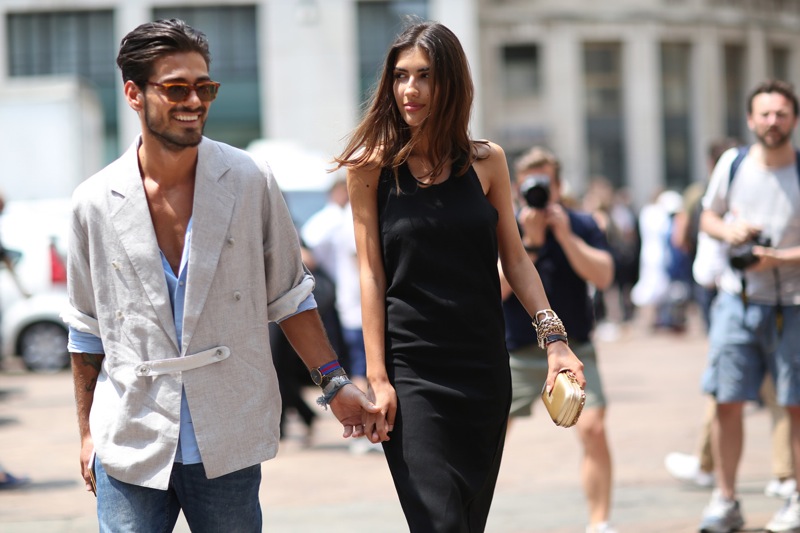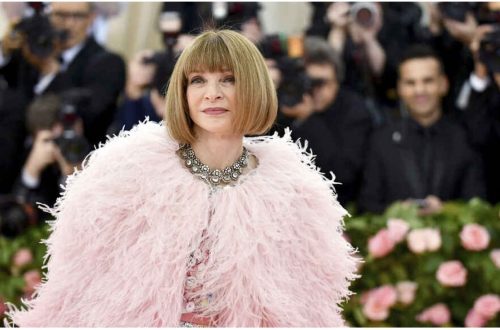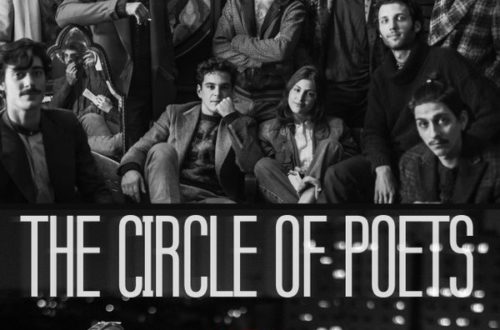Conference
“Communication Trends in Fashion Industry” by BS4F
- Introductive greeting by Pierandrea Miglietta (moderator) on behalf of the association
- Introductive greeting by professor Erica Corbellini
- Intervention by Patricia Manfield and Giotto Calendoli
 Patricia Manfield: 22 years old, from Naples. Has always had a passion for photography and image. Leaving for London, where she attended some short courses at Central Saint Martins, she discovered a great love for marketing. She moved to Milan a year and a half ago with her boyfriend and now attends the Fashion Business course at Istituto Marangoni.
Patricia Manfield: 22 years old, from Naples. Has always had a passion for photography and image. Leaving for London, where she attended some short courses at Central Saint Martins, she discovered a great love for marketing. She moved to Milan a year and a half ago with her boyfriend and now attends the Fashion Business course at Istituto Marangoni.
Giotto Calendoli: After having finished high school he moved to London where he lived for three years. It is in London that he encountered the world of fashion and had the chance to collaborate with Alexander McQueen. He traveled around the world and moved back to Naples at the age of 22 where he collaborated with a clothing brand and was in charge of the creative part. He then decide to move to Milan with his girlfriend Patricia Manfield.
Questions:
1) Between the multitudes of fashion blogs existing nowadays, what do you think contributed to the success of The Atelier?
Even though there are numerous blogs these days The Atelier had a boom in this last year and managed to become successful for various reasons:
-Patricia and Giotto are a couple in life and at work, so the blog has two points of view, therefore it is possible to have a universal target
– There is a perfect balance between fun and work
– Since the beginning there was a clear vision of the project: The objective is to have a high positioning. Meet and Match street style and high fashion in order to be closer to young people
– Street style was fundamental: It allowed a broad explosion on different media therefore a greater diffusion of the blog
2) How do you manage the different contents?
A blog is like a personal diary, in which, a part from fashion weeks and travel, we try to express ourselves and our passions. Recently we inserted a food section because of Giotto’s great passion for cooking.
3) Which are the major difficulties you encountered?
For Patricia the main difficulty was to manage work and study. However having studied economics she was well aware of how to make a company work, so she manages her blog both personally and managerially. The risk however is to compromise one’s image by making the wrong choices.
4) The moment of the launch was surely one of the most important, how was it managed in your case? Which were the initial difficulties? Is an idea enough or is it necessary to combine other resources? Is it necessary to make a monetary investment or the simple idea combined to the correct communication can lead to success?
There was no monetary investment. Since the beginning they were directed to an extremely high quality in terms of contents in order to express their way of being. Being in a 2.0 era it is easier to launch and manage a blog even without any economical resource. Now though there is a managerial structure that helps The Atelier for what regards organisation.
5) What relationships do you have with fashion brands? Do they look for you to sponsor products?
There is reciprocal esteem. The collaborations are often requested by brands. Bloggers decide whether to accept based on the target clients, personal tastes or brand values. Once the collaboration is approved projects start to be defined based on target clients and various strategies on how to communicate to the client start to be studied. Many can have an erroneous perception on bloggers and on their importance: in reality they are the perfect meeting point between brands and the final client. Fashion bibles are more objective and clients tent to be less loyal. If a brand has a target age of 16-30 and the chosen market is Asia, the brands contact bloggers because they are more effective in communicating. Consumers trust bloggers more because they feel more close to them.
Intervention of Adriano Cisani:
Adriano Cisani, 23 years old, has studied product design in IED, Milan. His passion for photography was born when he found an old photographic film in the attic. One year and a half ago he participated to his first show, Dolce and Gabbana. He now works as a street style photographer.
Questions:
1) How was the idea of the simplicity of your photos born?
It was born thanks to past experiences and propensity to all that is new.
His payoff is: “life is not serious”. There is often an excess of seriousness in fashion weeks. Adriano believes fashion icons are just normal people who perform a job like any other. That’s where the concept of his site comes from. Most street style photographers use a classical approach, but the aim of the reporter is to report what actually happens, both positively and negatively.
2) Regarding your relation with Vogue, how does a shooting work?
For a photographer it is essential to know how an editorial staff works and what happens in the editorial staff, this allows the creation of a good final product. Traditional photography is very set: there is a project and it has to follow the idea of the magazine, brand or stylist. In street style it is the photographer who is totally independent: he gives the magazine what he wants to give. In Andrea’s case he has total photographic freedom: he shoots what he desires and decides what to sent the magazine, without any constraints.
3) How will photography react towards the new trend of “fashion films”?
Photography will always remain, because it represents an instant. Editorial videos will surely acquire more importance but there will always be space for both.
Third intervention: Fabio Messana
Editor of Vogue Jewelery and stylist. His journey was transversal: he started as an architect and then became a journalist. He now works on fashion editorials for the magazine: he works as a stylist and coordinates projects that are systems that constitute a journey of communication intentions that translate to an image.
A fashion editorial is a project composed of various elements: emails, meetings, and budget. Pure creativity does not win out but is accompanied by marketing and managing budgets. A good picture is created between the perfect balance of ideas, creative force, budget and managing human resources.
Questions:
1) What are the responsibilities of an editor?
The main responsibility is to translate concepts into images and contents into concepts, for example fashion editorials. An editor has to translate quickly and immediately trends decided by the editorial staff
2)How are magazines managing the birth of new media?
New medias have opened the golden Olympus of the fashion world and have given the possibility to be used by users that did not have the possibility to access it before. Trends that used to come out on Vogue a month after the fashion show are now posted few minutes after it. Printed-paper has to deal with the new media because it risks of losing credibility if contents are published late. For what regards communication paper still maintains authoritativeness. The editor justifies trends previously communicated by bloggers.
Furthermore, taste have changed: blogs and street style photography have created new aesthetic canons, which magazines need to keep in count. High fashion is always more and more mixed with street style and ready to wear. This broke aesthetic parameters which were untouchable before. The same can be said about an actual photo: street style permits “ugly”, “movement” etc. to become an actual will of the photographer. There has been a democratisation of images also thanks to initiatives such as the “Vogue experience” organised by Franca Sozzani.
Adriano Cisani Intervenes: Street style was born as a consequence of the evolution of the fashion world. Fashion was regarded as aristocratic, but with the 60’s and 70’s and the pop era fashion became of young people. But when was street style born?
Messana replies that he does not know exactly when there was the big bang of democratization of fashion and street style but surely fashion is not pure creativity but also reflects economy, politics but most of all society.
Adriano Cisani: Thanks to Social Networks it is surely more diffused.
Messana: In the last years there has been a huge growth of photographers and bloggers, who often bypass quality. The thought that everybody can participate is worrying, but at the end there will surely be a selection.
Adriano Cisani: Other then being a good street style photographer it is essential to be constantly updated and research during all the year. Thanks to experience it is possible to forecast the trends of upcoming collections. In the last season trends are not classic, but brands are creating collections which are always more social friendly: such as Moschino, Fendi, Chanel.
Professor Corbellini: Probably nowadays entry barriers are very easy to cross and the fashion worls is more accessible, but barriers to success remain the same. To pass the final selection it is essential to have the right competencies that are obtainable through a good knowledge of the fashion world. Apparently it seems that everything is accessible to everybody but in the long run there will be a natural selection because passion has to be combined with knowledge and competence.
Are the roles of stylist and editor ever in contrast?
Messana’s job is not just pure creativity but has to respond to strong orders. The editor’s job has a structure that has parameters to respect, there is still space for self expression though.
Questions from the audience:
1) Question for Patricia Manfield: How were the first contacts with brands managed? For example in the Styligion editorial how did you realize that the bran was looking for you?
There can be forecasts on how the blog will work. When there is attention towards a blogger by a brand, then other brands start to get informed on the blogger. The first contacts and shootings are adventures that allow professional growth, a big aid comes from social networks, like Instagram. For example Styligion saw that Patricia and Giotto were in Los Angeles thanks to a picture published on Instagram and contacted them.
2) Question from a bijoux designer to Patricia:
The brand chooses the style and upon that is based the project with the blogger. But if a brand wants to communicate something else, like the value of “Made in Italy”, how can that be communicated through the blog? Is it possible to communicate something that is not style?
Answer: If the blogger is in line with the values of the brand it automatically represents them and can represent the product.
3) Question to Fabio Messana: What has to be communicated in the fashion world?
Magazines are communication tools: every tool has its language and different tools communicate different things. But some values are impossible to communicate with a magazine for example, but can be communicated through interviews for example. It is necessary to choose the correct tool.
4) Question: Social media platforms are becoming more powerful. Photography is more visible that an actual blog and blogs are losing their appeal. Does an immediate image compromise the blog’s mission?
Manfield: Blogs are becoming more monotonous and the site is loosing visitors because of social media.
5) Question to The Atelier: how do you see yourself in 5 years?
The blog wont be our eternal job but it is important to seize occasions and to be able to renew. Patricia is studying Fashion Business because she knows she wont work with her image forever. The objective is to shift the attention of her audience towards something she will create.
6) Question to P. Manfield: What is the difference between communication tools?
Communication on Social Networks is different based on what goal the brands want to achieve: some brands want images to be quickly posted on Instagram in order to promote a product fast and others want the blogger to consider the product more in depth, which is the approach Patricia prefers. However both situations are useful to reach the blog’s objective.
7) Question: What do you think about the trend of materialisation of logos in some fast fashion brands?
Patricia Manfield: Fast fashion brands do not need a logo because they are accessible to all. For example Zara never had a real logo because the brand’s strategy consists in gathering information about their clients and offering them what they desire at the fastest pace possible. H&M add status symbol because it collaborates with designers, therefore gains more credibility.
Fabio Messana: For fast fashion brands communication is aspirational to the fashion product because these brands create products which are similar to high fashion ones, but accessible to all under an economic point of view.
8) What is the aim of designer collaborations with H&M?
Professor Corbellini: The collaboration offers advantages to both parties and is s strong communication tool: it allows H&M to have prestige and allows designers to become more accessible to a younger public.
Translation by Beatrice Crivelli





